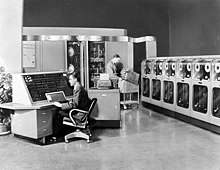 Global Information
Global InformationUNISERVO I information

The UNISERVO tape drive was the primary I/O device on the UNIVAC I computer. It was the first tape drive for a commercially sold computer.
The UNISERVO used metal tape: a 1⁄2-inch-wide (13 mm) thin strip of nickel-plated phosphor bronze (called Vicalloy) 1200 feet long. These metal tapes and reels were very heavy with a combined weight of 25lbs.[1] Data was recorded in eight channels on the tape (six for the data value, one parity channel for error checking, and one timing channel) at a density of 128 bits per inch. The tape could be moved at 100 inches per second, giving a nominal transfer rate of 12,800 characters per second. Data were recorded in fixed size blocks of 60 words of 12 characters each. Making allowance for the empty space between tape blocks, the actual transfer rate was around 7,200 characters per second.[2]
The UNISERVO supported both forward and backward modes on read or write operation. This offered significant advantages in data sorting and merging applications. The data transfers to/from the UNIVAC I processor were fully buffered in a single block dedicated memory, permitting instruction execution in parallel with tape movement and data transfer. The internal serial data path permitted inserting a tape data block into main memory in one instruction.
UNIVAC continued to use the name UNISERVO for later models of tape drive (e.g., UNISERVO II, UNISERVO IIIC, UNISERVO VIII-C) for later computers in their product line. The UNISERVO II could read metal tapes from the UNIVAC I as well as use higher density PET film base/ferric oxide media tapes that became the industry standard. While UNIVAC was first with computer tape, and had higher performance than contemporary IBM tape drives, IBM was able to set the data interchange standard. UNIVAC was later forced to be compatible with the IBM technology.
- ^ "Tracking the history of magnetic tape: A game of noughts and crosses".
- ^ Welsh, H. F. & Lukoff, H (1952). "The Uniservo - Tape Reader and Recorder" (PDF). American Federation of Information Processing Societies.
{{cite journal}}: Cite journal requires|journal=(help)